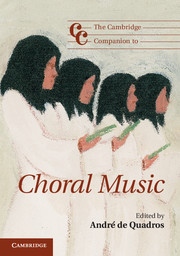Book contents
- Frontmatter
- 1 Introduction: choral music – a dynamic global genre
- Part I Choral music: history and context
- Part II Choral music the world over
- 6 Choral music and tradition in Europe and Israel
- 7 Canada's choral landscape
- 8 A multiplicity of voices: choral music in the United States
- 9 A hundred years of choral music in Latin America 1908–2008
- 10 Choral music in East Asia: China, Japan, and Korea
- 11 New voices in ancient lands: choral music in South and Southeast Asia
- 12 From chanting the Quran to singing oratorio: choral music in West and Central Asia
- 13 Voices of the Pacific: the (ch)oral traditions of Oceania
- 14 Choral music in Africa: history, content, and performance practice
- Part III Choral philosophy, practice, and pedagogy
- Notes
- Select bibliography
- Index
- Cambridge Companions to Music
9 - A hundred years of choral music in Latin America 1908–2008
from Part II - Choral music the world over
Published online by Cambridge University Press: 28 September 2012
- Frontmatter
- 1 Introduction: choral music – a dynamic global genre
- Part I Choral music: history and context
- Part II Choral music the world over
- 6 Choral music and tradition in Europe and Israel
- 7 Canada's choral landscape
- 8 A multiplicity of voices: choral music in the United States
- 9 A hundred years of choral music in Latin America 1908–2008
- 10 Choral music in East Asia: China, Japan, and Korea
- 11 New voices in ancient lands: choral music in South and Southeast Asia
- 12 From chanting the Quran to singing oratorio: choral music in West and Central Asia
- 13 Voices of the Pacific: the (ch)oral traditions of Oceania
- 14 Choral music in Africa: history, content, and performance practice
- Part III Choral philosophy, practice, and pedagogy
- Notes
- Select bibliography
- Index
- Cambridge Companions to Music
Summary
In order to understand the choral activity of the last hundred years in Latin America, it is important to summarize the history that shaped this region since the sixteenth century.
Choral music, understood as organized part singing, did not exist in any of the indigenous civilizations of the American continent. This art was established by Spanish immigration, through the Catholic Church, because its missionaries were responsible for education in general and particularly for musical training. During colonial times, choral music developed in the cathedrals, missions, brotherhoods, and religious societies.
The development of music in these territories took place between 1500 and 1820.
Cathedrals
Cathedral choral music was highly developed in the Virreinato de Nueva España in Mexico City, Puebla, and Guatemala, and later in Cuba; in the Virreinato de Nueva Granada in Bogotá and later in Caracas; in the Virreinato of Perú in Lima and Cuzco; and in the Virreinato del Río de La Plata in La Plata.
Most masses, magnificats, requiems, laments, and motets (many of them polychoral) were composed in Latin for church services, following the Renaissance and baroque styles of the music from the cathedrals of Seville and Toledo in Spain. It is not surprising, therefore, that works by Morales, Victoria, Guerrero, and Palestrina, among many others, are found in the archives of the cathedrals in Santa Fé de Bogotá, Lima, and Mexico City. Other works composed in Spanish or in Amerindian languages were inspired by the villancico, a Spanish genre, allowing for the incorporation of new rhythmic and contrapuntal patterns.
- Type
- Chapter
- Information
- The Cambridge Companion to Choral Music , pp. 130 - 148Publisher: Cambridge University PressPrint publication year: 2012



